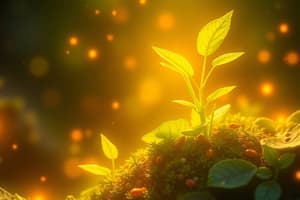Podcast
Questions and Answers
What is the immediate result of chlorophyll a absorbing light energy?
What is the immediate result of chlorophyll a absorbing light energy?
- The chlorophyll molecule gains a negative charge.
- ATP is converted to ADP.
- Water molecules combine.
- An electron in chlorophyll a gains energy and becomes 'excited'. (correct)
The light-independent reactions directly require light to convert carbon dioxide into carbohydrates.
The light-independent reactions directly require light to convert carbon dioxide into carbohydrates.
False (B)
What two energy-carrier molecules are produced during the light-dependent reactions of photosynthesis?
What two energy-carrier molecules are produced during the light-dependent reactions of photosynthesis?
ATP and NADPH
During photolysis, water is split into oxygen, hydrogen ions, and free ________ .
During photolysis, water is split into oxygen, hydrogen ions, and free ________ .
If a scientist discovered a way to inhibit the transfer of electrons to NADP+ during the light-dependent reactions (photolysis), what would be the most likely consequence?
If a scientist discovered a way to inhibit the transfer of electrons to NADP+ during the light-dependent reactions (photolysis), what would be the most likely consequence?
Flashcards
Photoactivation
Photoactivation
The initial stage where chlorophyll absorbs light, exciting electrons and leading to water splitting and energy transfer to ATP and NADPH.
Condensation & Phosphorylation
Condensation & Phosphorylation
Reactions where water molecules are split, and a phosphate group is added to an organic compound.
Redox Reactions
Redox Reactions
Reactions involving the transfer of electrons between molecules.
Light-dependent Reactions
Light-dependent Reactions
Signup and view all the flashcards
Light-independent Reactions
Light-independent Reactions
Signup and view all the flashcards
Study Notes
- When chlorophyll a absorbs light energy, an electron becomes excited.
- The excited electron is transferred to a primary electron acceptor.
- This process oxidizes the chlorophyll molecule, giving it a positive charge.
- Photoactivation of chlorophyll a results in water molecules splitting.
- Energy is subsequently transferred to ATP and reduced nicotinamide adenine dinucleotide phosphate (NADP).
- Photosynthesis involves condensation reactions.
- Phosphorylation (the addition of a phosphate group to an organic compound) occurs.
- Oxidation/reduction (redox) reactions involving electron transfer also take place.
- Photosynthesis is a two-stage process.
Light Dependent Reactions
- Light-dependent reactions occur in the grana.
- They require direct light energy to create energy-carrier molecules.
- Light energy is trapped by chlorophyll to produce ATP (photophosphorylation).
- Water is split into oxygen, hydrogen ions, and free electrons (photolysis): 2H2O -> 4H+ + O2 + 4e-
- Electrons react with nicotinamide adenine dinucleotide phosphate (NADP).
- NADP+ is reduced to NADPH: NADP+ + 2e- + 2H+ -> NADPH + H+
Light Independent Reactions
- Light-independent reactions occur in the stroma.
- ATP and NADPH from the light-dependent reactions are used to produce carbohydrates from carbon dioxide (reduction).
- Glyceraldehyde 3-phosphate (a 3-carbon molecule) is initially formed.
Studying That Suits You
Use AI to generate personalized quizzes and flashcards to suit your learning preferences.



